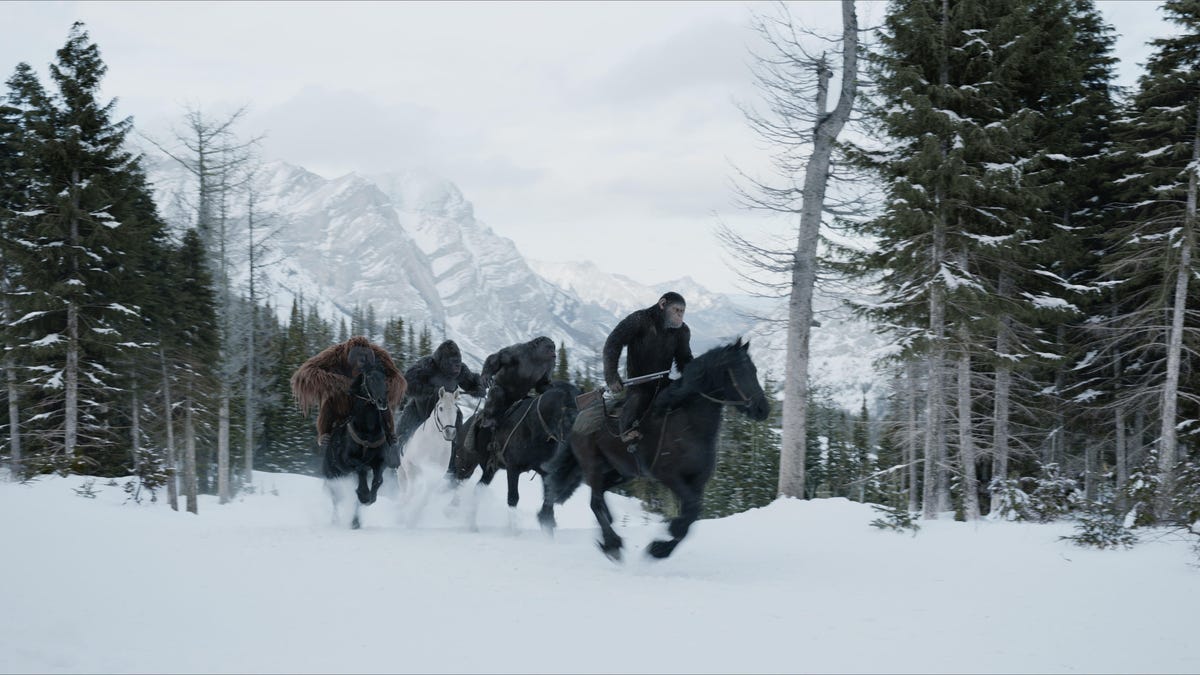'War for the Planet of the Apes' is ape-solutely astonishing
It's gorilla warfare for Andy Serkis and friends in a jaw-dropping marriage of eye-popping effects and spellbinding performances (no spoilers).

Something strange happened around three quarters of the way through "War for the Planet of the Apes".
It was only after well over an hour that I noticed there's barely a handful of human characters in the film. I was so absorbed in the hopes and fears of the lead characters it didn't even occur to me the characters I was so invested in were all CGI apes.
Well I'll be a monkey's uncle. "War for the Planet of the Apes" isn't just good -- it's astounding.
I have to admit I rolled my eyes back in 2011 when Hollywood had another crack at rebooting the "Planet of the Apes" franchise. From the startling 1968 original through several increasingly kitschy sequels, a TV series and a clunky Tim Burton reboot, I thought this idea had been done to death. But "Rise of the Planet of the Apes" and sequel "Dawn of the Planet of the Apes" did more than bolt on modern-day CGI effects -- they introduced us to simian characters with genuine personality to match their photo-realistic looks.
Cleverly, "Dawn" and "War" writer Mark Bomback and director Matt Reeves also shifted the narrative between human and ape until here, in "War", the apes are the whole story.
A bravura early shot sets the tone for what will follow. "War" opens, suitably enough, with a brutal "Saving Private Ryan"-esque battle pitching high-tech soldiers against apes armed with spears and bows, complete with an overhead drone shot Spielberg would have killed for. Gorilla warfare indeed.
But our perspective shifts from humans to apes in a stunning post-battle tracking shot moving through the decimated ape colony. As we walk among them, ape after ape turns to the camera, each face full of grief and fear and anger. Dozens and dozens of faces, every one an individual in its own right. The sheer number of CGI creations in one shot is impressive, but the character in all of them is astonishing.
The film belongs to the colony of apes led by Caesar, played by performance capture pioneer Andy Serkis -- who surely deserves Oscar consideration for his by turns dignified, angry, compassion-filled rendition.
Each of the other apes has a distinct personality, from franchise newcomer Steve Zahn's jittery chimpanzee to a pacifist orangutan to a simmeringly treacherous gorilla. It's an incredible marriage of cutting-edge technology with enthralling acting, with both the technology and the acting shown off in endless spellbinding close-ups of the apes' emotion-streaked faces.
Steve Zahn as a child-like chimp in "War for the Planet of the Apes."
"War" is little short of a milestone in visual effects technology. You can see every hair and eyelash on the apes' expressive faces. Snow settles delicately on ape fur. Rain slicks their hair to their bodies. Chapped and bleeding lips twitch to bare fangs.
But most of all, the apes' eyes glisten with life. The time and money invested in the visual effects pay off hugely -- effects maestros Weta clearly weren't paid peanuts to manufacture these monkeys.
Woody Harrelson channels "Apocalypse Now" demagogue Col. Kurtz in "War for the Planet of the Apes".
There are some humans involved. Woody Harrelson looms over the story as a vengeful colonel leading an army of fanatical soldiers. But we get to know only one of his soldiers, and I'd be surprised if even Harrelson himself has more than a couple of pages of dialogue.
The human characters don't come off very well, ruled by a ruthless demagogue building a wall to isolate a stronghold covered with fascistic slogans. In case the symbolism isn't clear, a certain very patriotic piece of music plays over one particularly brutal scene.
The apes also take in a young girl, played by 12-year-old Amiah Miller. Unfortunately her story is a lot like the one in "Logan" but without the father-daughter dynamic, so it tends to fade into the background.
"War" takes its time going from war movie to prisoner-of-war movie -- the great esc-ape, if you will. But even if this section is a bit long, you can't fault a summer blockbuster influenced by "The Bridge on the River Kwai" (fun fact: French novelist Pierre Boulle wrote the original novels of both "River Kwai" and "Planet of the Apes").
Aside from Zahn's touchingly comic turn providing the odd flash of humour, this barrel of monkeys is a pretty dour affair -- it's certainly not "Wonder Woman" or "The Mummy". The ending is a bit overblown, especially after hinting at a surreal twist that never materialises. But it's also one of the smartest and most enthralling blockbusters you'll ever see, marrying astonishing effects with a riveting story and captivating acting, along with grandeur that borders on the Biblical.
Who would have thought a sequel to a reboot of a decades-old talking monkey movie would be such a cinematic milestone? "War for the Planet of the Apes" is the "Apocalypse Now" of talking monkey movies. On every level, this is a blockbuster to go ape for.
Tech Culture: From film and television to social media and games, here's your place for the lighter side of tech.
Star Wars at 40: Join us in celebrating the many ways the Force-filled sci-fi saga has impacted our lives.

